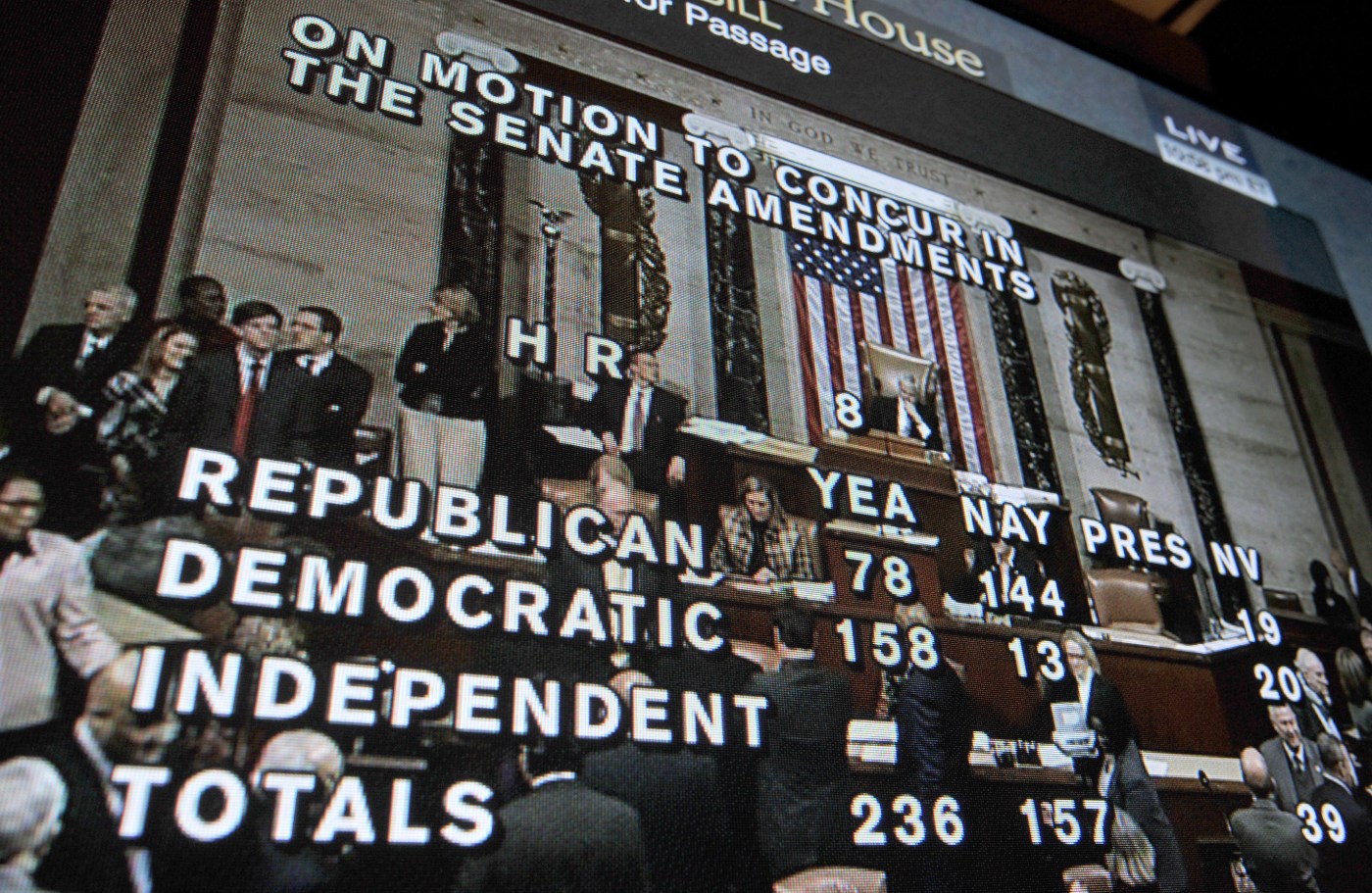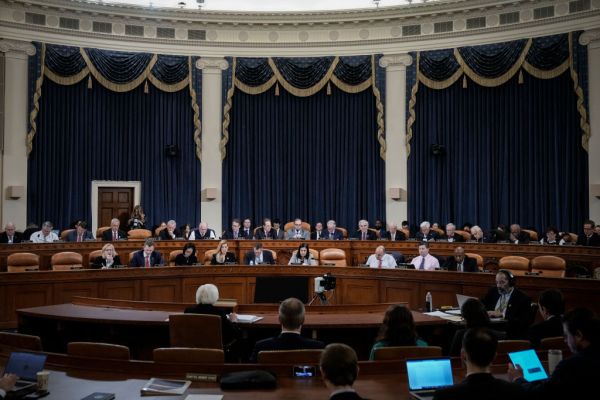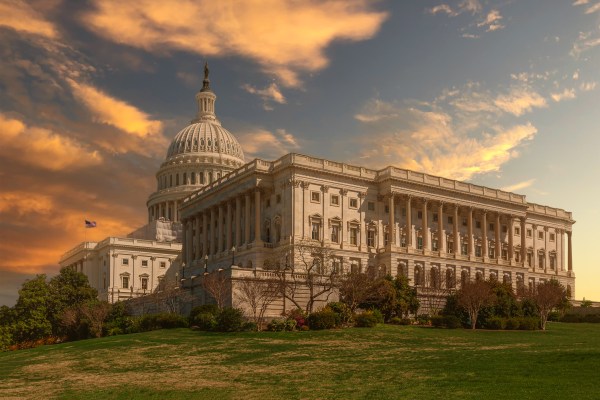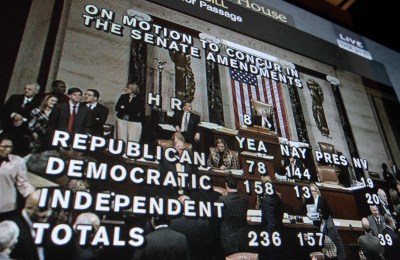This summer, longtime CNN Washington Bureau Chief Sam Feist is set to become the new CEO of C-SPAN. He’s taking over a venerable and respected Washington institution, which is really saying something these days. But the network is deeply intertwined with another Washington institution that is in far more sorry shape: the United States Congress. This transition in leadership may be a good time for C-SPAN to reflect on its own significant, if unintended, role in the degradation of the national legislature, and to consider whether a greater awareness of the costs of transparency might point it to some ways of helping mitigate Congress’ dysfunction.
The Cable-Satellite Public Affairs Network has been a fixture on Capitol Hill for almost half a century, broadcasting floor proceedings from the House of Representatives since 1979 and from the Senate since 1986. It has covered most committee hearings (on the air or online) since the mid-1990s. All of this coverage of Congress—along with a great deal of programming about public policy, history, and civics—has been offered in an exquisitely non-partisan way from the start, and always flavored with earnest sobriety. If you like the wonkier side of politics, you are surely a C-SPAN junkie. The network is hard not to love.
And yet, C-SPAN has also contributed to the deformation of Congress’ work—and of our political culture. This is not a function of how the network has approached its work, but of the very nature of its core purpose: televising floor and committee proceedings.
Since its launch, transparency has been C-SPAN’s watchword. Its purpose was to bring the People’s House to the people and let Americans see and hear what their representatives were up to. Yes, transparency is an essential democratic good. But all good things are a matter of degree, and there is such a thing as excessive transparency in political institutions.
Cameras have turned all of Congress’ deliberative spaces into performative spaces, leaving less and less room and time for members to speak and work in private. The most obvious consequence of this transformation has been the explosion of grandstanding in both chambers. There has obviously always been grandstanding in Congress, but the omnipresence of cameras has taken that vice to new lows. To make matters worse, the ubiquity of cameras has attracted cadres of members who understand public performance as the essence of the job.
But more important is what is not happening in Congress because of the presence of cameras. The institution’s core work is legislative negotiation, and negotiation cannot really happen in public. Politicians can’t afford to be seen making concessions or trading among key priorities in real time. They can be held accountable in public for what they ultimately produce or how they vote on a compromise bill, but to publicize the process is to suffocate it.
This reality hasn’t changed in the era of C-SPAN. Actual legislative bargaining still requires protected spaces for negotiation. But now, the leadership offices around midnight as a government shutdown approaches are often the only such spaces left, so it is hardly surprising that this is where a great deal of important legislation gets crafted.
That’s better than nothing, but leadership talks are not a substitute for bargaining in committee. Congress’ work plainly suffers from a shortage of negotiated agreements, and since Congress is the only venue for such horse-trading at the national level in our system, our entire political culture has grown more polarized as a result.
To be sure, televising Congress isn’t entirely to blame for this phenomenon. The increasing partisan embitterment of our political culture has been driven by a great many interlinked causes. But when it comes to Congress in particular, the transformation of deliberative spaces into performance stages has done serious damage. C-SPAN arose to advance an idealistic civic purpose, but has contributed to a demoralizing civic breakdown.
The solution is not to burn down C-SPAN. The network does a lot of good, educating viewers about public affairs and American history. And in any case, there is no turning back now from the televising (and YouTubing) of much of Congress’ work. But by taking account of the problems to which it has contributed, C-SPAN could help advance some solutions.
One useful step might seem counterintuitive: To make Congress just a little less performative, C-SPAN should push for a loosening of the reins on its coverage of the floors of both chambers. The House and Senate floors are not where most bargaining has ever happened in Congress. They are venues for voting, and on rare occasions also for debate. But since the televising of floor action began, they have also been prime venues for grandstanding, because Congress’ rules require C-SPAN to only show close-up shots of the person speaking. This keeps the audience from seeing that the speaker is often addressing an empty chamber, and the dramatic video clip is purely for show. It turns C-SPAN into reality television, rather than facilitating the televising of Congress’ reality. Wide shots of the House floor could cut down on the production of such clips.
We know that could help, because Congress actually let C-SPAN do this for several years in the late 1980s and early 1990s. To curb made-for-TV grandstanding by Newt Gingrich and others, Democratic House leaders allowed C-SPAN to pan out during speeches. The House ended that practice in 1994, at Gingrich’s behest. C-SPAN has requested permission to resume it several times since then, to no avail, so there is no way to know if another push would succeed. But it’s worth a try, particularly as part of a broader effort to rethink video coverage of Congress.
That broader effort should particularly focus on creating space for some committee work to be done in private. Formal hearings will surely continue to be televised, and the case for undoing that is not one many politicians could afford to embrace. But committees in both houses could openly treat hearings as public performances and officially use them for that purpose while formally organizing a new mode of core legislative work: private working sessions devoted to floating proposals and hammering out legislative deals. Such business sessions, or whatever committees wanted to call them, would not replace hearings but supplement them. Ideally, they would provide members with a much-needed forum for genuine deliberation. If the experience of the intelligence committees is any guide, many members would love that private format.
And C-SPAN itself should not resist such change; it should encourage and welcome it. In fact, a further avenue for the network to help address some of Congress’ dysfunction would be to make Congress’ 21st-century problems a central focus of its programming over the coming years. Instead of ignoring the unavoidable effects that televising legislative work must have on that work, C-SPAN should lean into the fact that its medium and format can shape the culture of Congress—and should seek to shape it for the better.
The network could, for instance, regularly host formal, structured conversations among members of key committees from both parties, to give them a public venue to talk together about the work of their committee and their own priorities. In such a setting, the presence of television cameras would actually discourage grandstanding. It would also help members get in the habit of speaking respectfully with each other across party lines—and get C-SPAN junkies more accustomed to seeing that happen. Public discussion on C-SPAN’s terms could reinforce private discussions held away from the cameras.
C-SPAN could also launch a body of programming aimed at considering Congress’ challenges and dysfunctions and learning about potential reforms. That could involve hearing from experts about Congress’ history, learning about ideas for rethinking its rules and practices, drawing on the work of the House Select Committee on the Modernization of Congress, and giving both members and outsiders a chance to talk about how the institution could work differently. The audience for such programming would obviously be rather narrow, but reforming Congress only requires the support of its own members, and it’s a safe bet that C-SPAN can have some effect on their internal culture.
These are far from silver bullets, to be sure. But they are all modest ways for C-SPAN to acknowledge the costs of excessive transparency in Congress, to lean into its identity and audience, and to acknowledge that today’s Congress is dysfunctional in some ways that prevent it from facilitating cross-partisan bargaining and accommodation.
Such negotiation across lines of difference is ultimately the purpose of the national legislature, and an essential purpose of the Constitution. The framers of our system understood that working toward negotiated bargains required some degree of privacy. The Constitution itself reflects that fact, since it was conceived by a convention held behind closed doors. “Had the deliberations been open,” Alexander Hamilton argued in 1792, “the clamours of faction would have prevented any satisfactory result.” Any observer of the contemporary Congress can see that he was right, that a Congress capable of advancing the cause of greater national unity requires some relief from the glare of the cameras.






Please note that we at The Dispatch hold ourselves, our work, and our commenters to a higher standard than other places on the internet. We welcome comments that foster genuine debate or discussion—including comments critical of us or our work—but responses that include ad hominem attacks on fellow Dispatch members or are intended to stoke fear and anger may be moderated.
With your membership, you only have the ability to comment on The Morning Dispatch articles. Consider upgrading to join the conversation everywhere.